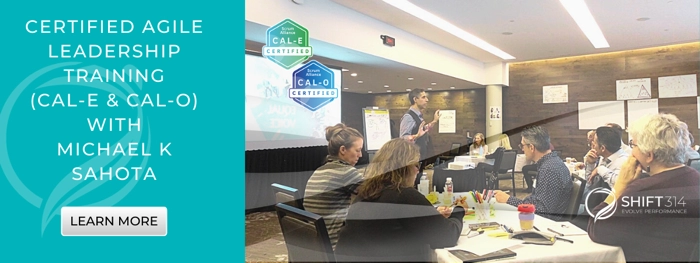Many organizations seek to improve their performance. Some even try moving to novel organizational structures with the promise of unlocking success. However, well-intentioned leaders often miss one vital point: all ambitions to change an organization rest on its culture. To quote Druckers’s now-famous maxim: “Culture eats strategy for breakfast.” And culture and leadership are more connected than many of us care to admit.
Culture Follows Leadership
The culture of an organization is the sum of all the people. Everyone impacts the culture around them – for better or worse. And leaders – those who hold power – have the greatest impact. The more senior the person, the greater their impact on the overall culture. Without a shift in leadership, culture change is simply not possible. The notion of assigning culture shift to Human Resources or a transformation team simply does not work in practice. Thus, culture and leadership are inextricably linked. But how can a leader create a cultural shift?
What Is Culture?
Before we dive into culture and leadership, let’s clarify what we mean when we’re talking about organizational culture.
Culture is the integrated set of behaviors of all the people in an organization. It’s the mindset, energy, and consciousness of an organization, together with all the tangible structures, practices, and policies. Together, these form the organization’s culture.
Organizational culture is actually about the people. The collective behavior of all the people in the organization creates its culture. If you want to change the culture of the organization, that requires a change in the behaviors of all the people involved.
Culture and Leadership Co-Evolve
Culture and leadership are so interconnected because leaders create culture with every interaction they have within an organization. There are two primary ways that leaders impact culture.

Number one is through how they are. Leaders impact culture through their way of being, how they hold themselves, and even how they’re feeling internally. Every human being has a built in sensor to check how other people are feeling around them. When a leader is relaxed, open, and curious, that gives the people around them the psychological safety that they need to function at a higher level. We call this aspect of influence “Being.”
Number two is through what they do. What does the leader actually do? Are they taking actions that demonstrate that they care about people? Are they listening to what’s happening around them? Are they making decisions that are in the best interest of the people in the organizational system?
Put together, these two aspects of leadership have a profound impact on an organization’s culture.
Culture, Leadership, and Personal Growth
Why is it important for leaders to focus on personal growth? The answer is simple: culture follows leadership. When a leader has an evolved consciousness and interacts with the people in the organizational system, they create a high-performance organizational system around them.
The way to create a very high-performance organization (called a “Teal organization” in the Laloux Culture Model) is very simple: just show up as an evolutionary leader.
The Leadership Gap
The truth of the matter is that most people don’t show up as evolved leaders most of the time. They actually show up as very traditional leaders, because a lot of dysfunctional behavior patterns are coded into how we’ve been taught to behave since we were very young. For example, trying to convince people, trying to sell our ideas, and being overly attached to our ideas.
There are many conditioned behavior patterns that leaders have, and it’s important to grow out of them in order to show up as more evolved leaders. Leaders who accomplish this can inspire a shift in all the people to create a high-performance culture.
How to Grow as a Leader
Since culture and leadership are inseparable, the question for leaders becomes, “How can I grow so that the culture I create is high performance?” Let’s explore some of the most important qualities of high performance leaders.
Emotional Regulation
Evolutionary leaders are able to understand how their emotional system works and navigate their emotional disturbances. It’s not about becoming a robot, it’s actually about becoming a real human being who is honest about what’s actually happening. The leader who feigns calm comes across as inauthentic. But a leader who demonstrates healthy emotional regulation fosters a psychologically safe environment.
Psychological Safety
High-performance leaders hold a very high degree of psychological safety. They’re able to stay calm and unflappable no matter what’s going on around them. When a leader has psychological safety and walks into a room where everyone’s in a panic, they can say, “Hey everyone, everything’s going to be fine. We’ll work it out somehow.” When a leader has psychological safety, they can propagate that state to other people so that they feel psychologically safe.

Leaders Go First
Another thing that we see with evolutionary leaders is that they focus on their own growth and evolution. When leaders go first, they show everyone that they’re on their leadership journey too, that it’s okay to be imperfect, and that learning is part of everyone’s job. When leaders model that for everyone, that’s the foundation of creating a learning culture. And a learning culture is essential to creating an adaptable organization, because without learning, there’s no growth or innovation–and no hope of adapting to the complex business world that organizations exist in.
Authenticity
Authentic leaders focus on relationships and building trust. They understand that an organization is not a machine, it’s a collection of people, and that helping people evolve and grow is one of the most important things they can do. In addition, they’re also vulnerable. They’re ready to share exactly what’s going on with them. And when leaders are vulnerable, it creates connection. It’s the foundation of creating the trust and the psychological safety that employees need to function at their best.
Being vulnerable is being able to surrender in a complex situation. One example is leaders dropping the facade that they’ve got it all together. Powerful leaders say things like, “I don’t know the solution to this, but I believe we can all work this out together.” And when leaders are that authentic and vulnerable, it opens up the door for the extraordinary to emerge from organizations.
Listening First, Talking Last
High-performance leaders listen first and talk last. By listening first, they show that they respect other people’s input and voices. Leaders who listen first are able to very practically influence organizational culture in a positive direction.
Of course, this kind of change requires an inner shift in the leader’s consciousness or mindset. Most of us are afflicted with the challenge of the ego running the show. The ego wants to talk and express itself, and so it doesn’t create places for others to contribute. Even a simple activity like listening first requires a lot of inner growth for most leaders.
Sharing Power
Leaders who understand the paradox of power know how to share power effectively with workers and peers. They know when to share power, how much power to share, and when to give away power completely or stay involved in decisions. Through this effective sharing of power, leaders develop other leaders around them. They help build systems that can operate while they’re away on holiday.
To feel comfortable sharing power and to actually want others to be successful requires an inner shift in mindset. The built in mechanism of the ego is that we want to take all the credit for ourselves; we want to look like the star. However, high performance leaders help their people become stars and they move themselves to the background.
How to Lead Better Meetings
Here’s an example of positive culture and leadership in action. It’s also a technique you can use to lead much better meetings. As the leader, let’s say you’re looking to solve a problem. Oftentimes, leaders go in and propose what they think the solution is and then say, “Does anyone have any input or advice?” They often hear very little feedback.
If you’re interested in creating better outcomes for your organization and developing other people to be leaders, there’s a very simple practice you can do: at the beginning of the meeting, just set up the problem but don’t offer a solution. Here’s how it can work:
- At the beginning of the meeting, say something to the effect of, “Hey, we’re here to solve challenge X. I’ve got some ideas, but I’d like to hear what you think first.”
- Everyone else shares their input first, before having any discussion. Just have everyone share their thoughts on the topic.
- Once everyone’s had a chance to speak and share their ideas, you can guide the group through an open discussion of what will be most effective.
What happens is that you’re able to help people contribute to the solution and recognize their contribution. Ultimately, this helps develop people as leaders. What’s even more important is you’re using the collective wisdom and intelligence of all the people to make the best decision possible.
Oftentimes as the leader, you don’t even need to make the decision anymore. You can just say, “Hey, it all sounds like we’re in agreement that solution X is the best option. Great. Let’s go do that.” This is a very practical way that leaders can model positive culture and leadership while developing the people in their organizational system.
Taking the Leap: Becoming an Evolutionary Leader
There are many ways that people can grow as leaders. Here at Shift 314, we have created a technology of consciousness that helps leaders experience a rapid inner shift and gives them the practical external tools to interact in new ways that unlock performance.
Practical tools include strategies for:
- Deep listening
- Enhanced learning
- Interacting with people
- Understanding alignment within the organizational system
- Observation skills for a deeper level of understanding
- Navigating complexity
- Effective facilitation
We also offer vital practices that leaders need to show up as high-performance leaders that are able to manifest a change in culture. This includes understanding decision-making, understanding how to share power effectively, and understanding how to use technologies such as the advice process to help people become leaders.

On the “doing” side of the equation, we provide detailed training in everything from how to listen and how to facilitate meetings to how to send emails and share information. It’s repatterning and relearning all of these normal practices in ways that are more engaging, that help people model a more evolved way of working that leads to greater employee interaction and helps build other leaders within the organization.
The “being” side of the equation is an inner shift in consciousness. What we see for leaders who create high performance organizations is they have a different view of themselves, the world, the organization, and other people. The inner shift that’s needed is a shift in mindset to a more evolved worldview. We have created technologies of consciousness to help leaders go through this essential shift of consciousness and have a sustained impact on their organization.


